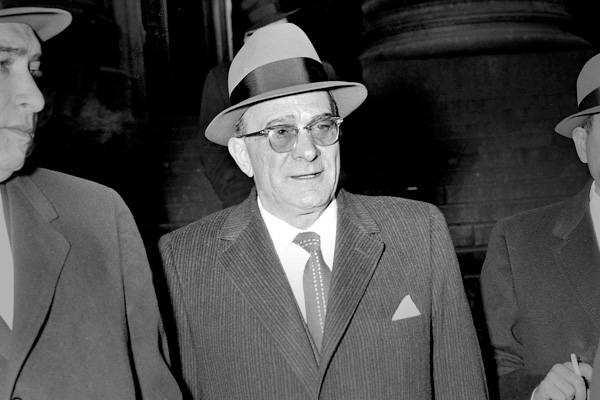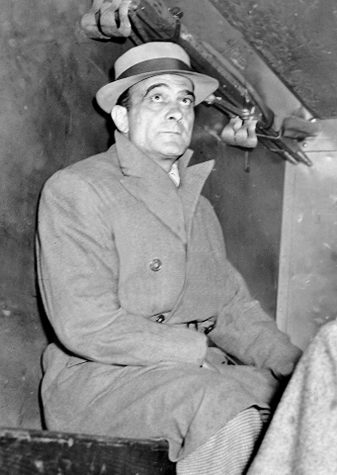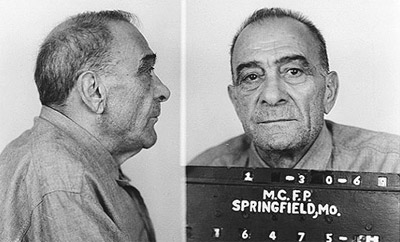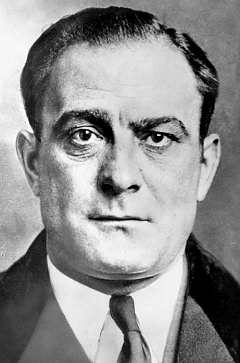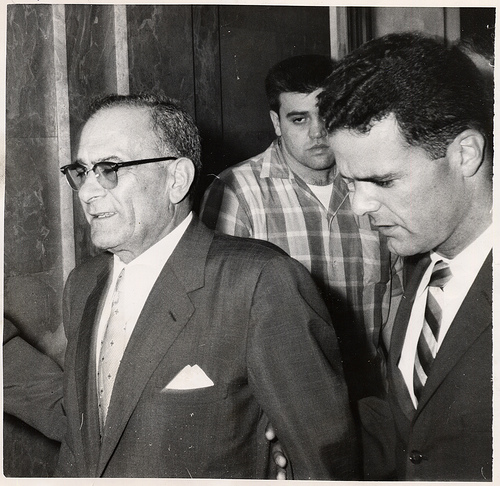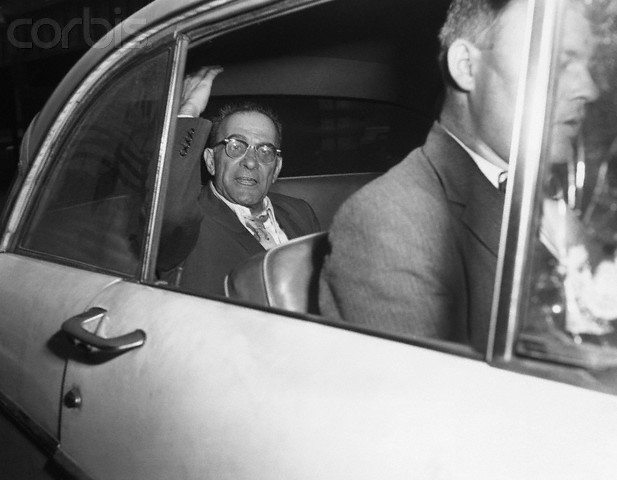<Back to Index>
- Boss of the Genovese Family Vito "Don Vito" Genovese, 1897
PAGE SPONSOR
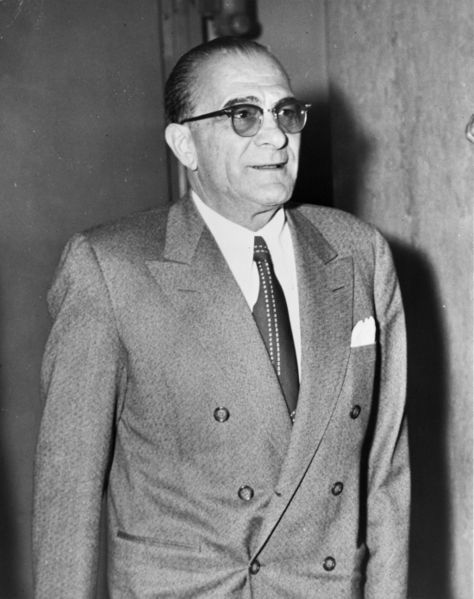
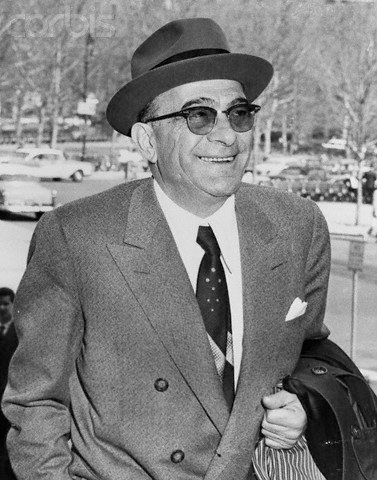
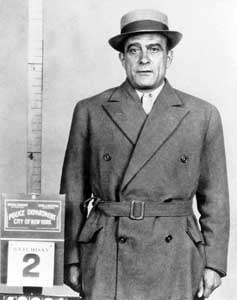
Vito "Don Vito" Genovese (November 27, 1897 – February 14, 1969) was an Italian mafioso who rose to power in America during the Castellammarese War to later become leader of the Genovese crime family. Genovese served as mentor to future mob boss Vincent "The Chin" Gigante. His two brothers Michael "Mike the Pipe" and Carmine Genovese joined him in the Genovese family, his cousin Michael James Genovese became boss of the Pittsburgh crime family.
After emigrating from Naples, with his father Felice, mother Nunziata and brothers Michael and Carmine, Genovese soon started working for the Mafia by serving New York boss Giuseppe "Joe the Boss" Masseria during the early 1920s. Involved in bootlegging and extortion, Genovese's main asset to Masseria was his propensity for violence. Charles "Lucky" Luciano was an early associate and benefactor of Genovese. Their relationship lasted 40 years, till Luciano's death. They started together as kids in the slums of New York City.
Genovese's
wife, Anna, whose signature was her dark glasses, later informed on her
husband (Anna's first husband, Vernotico, had been murdered two weeks
after Genovese had fallen in love with Anna). Although associates
expected Vito to order her execution, he later told Joe Valachi he couldn't bring himself to order the killing (as Bonanno crime family boss Phillip Rastelli would later do). Vito was a very thin man who stood at 5'7". He had a fondness for Cashmere wool coats and had bloodless eyes that always seemed to be staring. He is believed to have been the shooter of Gaetano Reina,
which led to the breakout of the Castellammarese War. In April 1931,
during the bloodiest part of the war, Luciano orchestrated the betrayal
and assassination of Masseria. Genovese was one of the four shooters who
murdered his former employer. Later that year, Luciano arranged a hit
on Salvatore Maranzano,
the victor in the gang war. With both Masseria and Maranzano dead,
Luciano established himself as the paramount gangster in the country.
Luciano now became the boss of his own Luciano crime family with Genovese as the underboss. Genovese became a naturalized United States citizen on November 25, 1936 in New York City. However,
in 1936 Luciano was convicted of pandering charges and sent to prison,
leaving Genovese as acting boss. In 1937, Genovese was indicted for the
1934 murder of Ferdinand Boccia. To avoid prison, Genovese fled to Italy that same year and settled in the city of Nola near Naples.
Genovese prospered in Italy, becoming a prominent Mafia leader there. He became a good friend of Benito Mussolini and was awarded the highest civilian medal the dictator could confer. In Naples, following the allied invasion in 1944, Genovese was appointed to a position of interpreter / liaison officer in the U.S. Army headquarters and quickly became one of American Military Government of Occupied Territories' (AMGOT) most trusted employees. It was a remarkable turnabout; less than a year before, Genovese had been acquitted for the murder of Carlo Tresca, editor of an anti - Fascist Italian language newspaper in New York, as a favor to Mussolini and the government.
While helping Mussolini's fascist government prosper, Genovese was also running an enormous black market operation with Calogero Vizzini, a powerful Mafia boss in Sicily. On August 27, 1944, the Military Police cracked down on the black market ring and arrested Genovese. When Agent Orange C. Dickey of the Criminal Investigation Division of the US Army investigated Genovese's background, he discovered that Genovese was a fugitive wanted on murder charges back in New York. The problem was nobody in the Army or the federal government was interested.
After
months of frustration, Dickey was finally able to make preparations to
ship Genovese back to New York to face trial. At that point, the
pressure started being applied to Dickey. Making less than $210 per
month, Dickey turned down a $250,000 bribe to release Genovese. When
that didn't work, Dickey was pressured through his military chain of command to release Genovese. Dickey refused to buckle under pressure.
Back on the streets, Genovese did not receive the top spot in the Luciano family that he had long expected. Frank Costello had taken over as boss when Genovese fled to Italy, and kept the post after he returned. Further aggravating Genovese was the fact that Willie Moretti, a feared New Jersey racketeer, had grabbed his old job as underboss. Genovese was busted down to caporegime of his old Greenwich Village Crew.
However, his long absence had lulled his enemies into a sense of security they would soon regret. A small time hoodlum claiming to be the triggerman in the Boccia murder, Ernest "The Hawk" Rupolo, had turned state's evidence after and named another hood, Peter LaTempa, as a corroborating witness. When Genovese returned to the United States, however, LaTempa sought protective custody. It was to no avail; LaTempa died a week after Genovese's return after his gallstone medication was poisoned. Without LaTempa's testimony, the state's case against Genovese collapsed, and he was acquitted. The presiding judge, however, stated that if LaTempa had still been alive, Genovese would have almost certainly been convicted and put to death.
During the 1950s, Genovese ordered the murders of Costello, Moretti and Albert "Mad Hatter" Anastasia. Only Costello survived, but he was frightened enough to give up control of the family. Genovese took over as boss of the renamed Genovese crime family, and was now at the height of his power. The coup against Costello and Anastasia was supported by the two biggest earners in the family, Anthony Strollo and Anthony Carfano. Soon after Genovese became the godfather, he would allegedly arrange for these two caporegimes to be murdered. Genovese loyalists Philip Lombardo, Gerardo Catena and Mike Miranda would assume the top positions in the family by the early 1960s.
In 1957, Genovese arranged the Apalachin Conference in the rural town of Apalachin,
New York, a conference for dozens of top mafiosi that he hoped would
confirm his position in the family. Unfortunately for Genovese, the
meeting (November 14, 1957) went horribly wrong. New York State Police Trooper Edgar Croswell had been watching the meeting house, which belonged to mobster Joseph "Joe the Barber" Barbara.
When Croswell saw large numbers of mobsters there, he called for
reinforcements and surrounded the farm. When the attendees were alerted,
they chaotically fled the location, some fleeing on foot into the
woods. Aside from derailing Genovese's power plan, the Apalachin Meeting
brought the Cosa Nostra out of the shadows and into the view of the public and law enforcement.
In 1959, Genovese was convicted of selling a large quantity of heroin. He was sentenced to 15 years in the Atlanta Federal Penitentiary in Atlanta, Georgia. Many court observers felt the chief witness, a low level criminal who claimed to have met Genovese, was lying. Years later, the witness would recant his testimony, saying that he had been released from prison in return for implicating Genovese.
Genovese continued to rule his family even from his cell. For instance, Rupolo was finally killed on his orders in 1964. Genovese had not killed Rupolo immediately upon his return, but forced him to live for almost 20 years in terror.
On February 14, 1969, Genovese died, of natural causes, while still in jail. He is buried in Saint John Cemetery in Queens.
Genovese is portrayed in the 2001 TV movie Boss of Bosses by Steven Bauer. Genovese is portrayed in The Valachi Papers by Lino Ventura.
